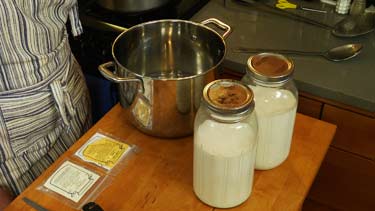Cheese-making enthusiast, and member of the Going Goaty Cooperative, Nori Gordon shows us how to make soft goat milk cheese (chèvre). In this demonstration she is using raw goat’s milk from her goat (the milking duties are split amongst the members of the cooperative), though as Nori says in the video, you can use pasteurized goat or cow’s milk instead of raw milk if you prefer.
Please note: it is especially important to follow proper sanitary guidelines when producing raw milk products. While Cooking Up a Story believes that this video contains accurate information to safely produce soft raw milk cheese, we rely solely upon the expertise of others and assume no liability for any adverse health consequences that may result from following this recipe.
For more of a perspective on the whole, raw milk food safety controversy, you may like to read this post by journalist, and food writer David Gumpert, The Raw Milk Debate: Thorny Issues of Food Safety, Food Rights, and Public Health
Traditional Soft Goat Cheese (Chevre) recipe
i gallon of goat’s milk makes about 1 1/2 pounds of cheese. Recipe courtesy of Nori Gordon.
Ingredients:
- 1 gallon Fresh Goat’s Raw milk (or pasteurized)
- 1 packet direct set Chevre culture (contains rennet)
or: ¼ tsp soft cheese or mesophilic starter culture and 1 drop liquid rennet diluted in 4 Tbsp of unchlorinated water.
Directions:
- Slowly heat milk to 86 degrees (use a double boiler method or a pot in a sink of warm water).
- Add Direct set culture (or culture and rennet) and let set for 12 hours at room temp (above 72 degrees if possible—that’s what those little mesophilic guys need to multiply)
- Line a colander with clean butter muslin in a tray or bowl and VERY GENTLY ladle curds into the colander. Tie the corners of the cloth together or wrap with a rubber band and hang over a bowl or sink for 12 hours.
- Place in a clean plastic or glass container and put in fridge. OR add salt to taste (1% of weight in salt recommended) or chop fresh herbs and roll logs of chevre/herbs….or submerge in olive oil in glass jars.
Basic cheese-making supplies to get you started:
- Most of these you can find in your kitchen, or be creative with what you have. The cultures, rennet, cheesecloth, butter muslin and cheese molds are the first investments you will need to make.
- A stainless steel pot (enough to hold 1 gallon milk) and another pot that it fits in to make a water bath possible.
- Colander—plastic or metal
- Metal strainers sieve type of all sizes
- Draining tray (dish pan, a metal rack that fits inside and a wooden cutting board on top, a sushi mat on top of that)….Or a similar set-up.
- Slotted spoon/skimmer spoon
- Long knife
- Wide mouth ball jars (pint and quart size)
- Lots of glass or plastic Tupperware, parchment paper, plastic bags,,,for storage in fridge
- Butter muslin (very thin weave)
- Plastic cheese molds (buy or make your own)
- Cheese cultures (stored in freezer)
- Cheese salt-non-iodized (kosher sea salt works great)
- Rennet (animal or vegetable liquid type—stored in fridge)
NOTE: All items should be sterilized before every use. Pots/strainers boiled or steamed for 10 minutes. Butter muslin and cheesecloth should be soaked in a dilute bleach or vinegar solution and then washed and dried.
Most of the videos featured on Cooking Up a Story were produced, filmed, and edited by Rebecca Gerendasy. Fred Gerendasy contributed as a writer to many of the posts and occasionally as the interviewer. Visit Rebecca Gerendasy Clay – Art and Fred Gerendasy Photography to see their current work.

